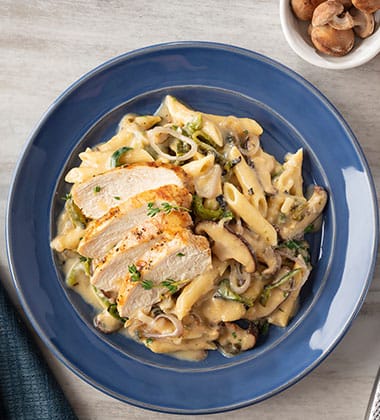In a rapidly evolving healthcare landscape, patient, resident, and guest satisfaction has become a top concern. Forty-eight percent of healthcare operators identified “improving patient/resident satisfaction” as their top priority.1
Key to satisfaction are the quality and variety of food offerings. According to Datassential, two-thirds of consumers find food offerings important for their care experience. In long-term care and senior living, this figure climbs to nearly 80%.2
Discover three ways to improve your food offerings and boost the healthcare experience.
Balance Health and Comfort
The desire for healthier and fresher options in healthcare facilities is growing, with 70% of hospital, 75% of long-term care, and 79% of senior living residents wanting healthy and better-for-you foods.3 However, feel-good dishes are also in demand: 42% of residents seek comfort food.1
Healthcare operators must recognize and cater to this dual need with comforting, better-for-you dishes. For instance, soup is often perceived as a healthy food choice, especially among younger consumers.4 Offering vegetarian and reduced-sodium soups can enhance perceptions of health and variety. For example, this “Creamy” Tomato Basil Soup Made With Campbell’s® Condensed Tomato Soup and Pacific Foods® Barista Series™ Oat Milk is a comforting, creamy plant-based tomato basil soup.
Another idea is to take comfort food favorites, such as fries, burgers, and mac and cheese, and make them healthier, an approach called “stealth health” by Healthcare Facilities Today. The idea is to make “palatable options healthier, and healthy options more palatable.”5 This tactic can significantly improve patient satisfaction without compromising nutritional quality. Consider this Beef Stroganoff Made With Campbell’s® Healthy Request® Cream of Mushroom Soup, which offers the rich traditional flavor of a stroganoff with a healthier profile.
Provide a Variety of Options
Variety is vital in healthcare food services, so offering a diverse range of menu items is essential. The majority of consumers in hospitals, long-term care, and senior living facilities—68%, 69%, and 70%, respectively—desire lots of variety each day.3 A similar majority—62% in hospitals, 71% in LTC, and 67% in senior living facilities—prefer menus that change and are frequently updated.3
Operators should consider introducing on-trend options, including global cuisine and seasonal menu items, to keep menus exciting and diverse. This adds an extra layer of engagement and satisfaction for patients, residents, and guests, according to Campbell’s Foodservice Executive Chef Gerald Drummond.
“It’s really about having a nice balance of food that is familiar with their residents and patients, and including global food because that is growing in demand within healthcare,” said Drummond. “We’re moving away from the more mainstream cuisines that we used to see, such as your meatloaf and mashed potatoes. Now, healthcare chefs are expected to stretch their imaginations from a global perspective as well as within the U.S.— incorporating more regionality or seasonal ingredients within the menu.”
Metz Culinary Management, for example, serves a selection of dishes from around the world in their initiative, Global Kitchen, at healthcare and college facilities. Dishes include toasted tikka masala, plant-based arepas, and Jamaican jerk pork.6 Consider, for example, this Butter Chicken With Rice made with Campbell’s® No Salt Added Condensed Tomato soup.
In addition to adding global, seasonal, and regional flavors and dishes, having a shorter menu cycle is key, according to Drummond. “Shortening the menu cycle to eight to 12 weeks ensures that they’re not getting the same thing two times a month or three times a month. That way, there’s always something new and exciting for those residents and patients.”
Cater to Dietary Needs
Understanding and accommodating dietary needs is crucial. Patients and residents often have specific dietary needs, everything from gluten-free preferences to liquid diet requirements. They want their food to reflect their dietary preferences, and the demand for these options is on the rise.7
While the top special diets offered were diabetic (56%), low-fat (49%), and sugar-free (47%), there has been a 56% increase in vegetarian and a 54% increase in vegan specialty diets over the past two years.1
Thirty-six percent of healthcare consumers express interest in including more low-sodium items on menus.8 Using low-sodium and heart-healthy products, such as Campbell’s® Low Sodium Ready to Serve, No Salt Added Condensed, and Healthy Request® Condensed Canned Soups, can make a big difference in meeting dietary needs across the menu. These soups can either be served alone as soups or used as the base for recipes like these Chicken and White Bean Enchiladas Made With Campbell’s® Healthy Request® Cream of Chicken Soup featuring a lightened creamy chicken filling.
Campbell’s® No Salt Added 50 oz. soups are also a great choice for customizing salt content for guests who have dietary considerations. With a low cost per ounce, these soups allow you to deliver on delicious flavor while reducing time and labor.
How Campbell’s Foodservice Boosts Satisfaction
Campbell’s Foodservice is at the forefront of enhancing guest satisfaction in healthcare settings. Our healthcare portfolio offers a wide range of products tailored to meet the diverse needs and preferences of patients, residents, and guests. We focus on taste, nutrition, and variety, ensuring that healthcare operators can provide exceptional dining experiences for all.
Learn more about Campbell’s Foodservice For Healthcare.
1 Healthcare Multi Client Study 2022 Technomic
2 “Hospital Food, Reimagined: Emerging Trends in Healthcare Foodservice,” Datassential Blog
3 Healthcare Segment Guide 2023, Datassential
4 Soup & Salad, Consumer Trend Reports, Technomic, 2022
5 Tolliver, Michael, “How Hospital Food Service Can Improve Patient Experiences And Outcomes,” Healthcare Facilities Today
6 Gingerella, Benita, “Metz Goes Global With Latest Concept,” Foodservice Director, October 4, 2023
7 US Healthcare Hospital Food Services Market, Markets and Markets
8 Healthcare Keynote, Datassential 2021



































